Lancaster
The earliest record I have for Lancaster is a French advertisement for Lancaster ‘produits beauté luxe’ placed by Georges Würz, parfumeur, in September, 1945. Würz went on to establish the Société Immobilière Lancaster (Société Anonyme Monégasque) in Monte-Carlo, Monaco in 1947 with a capital of 1 million Francs, increased to 3 million by the end of the year. Würz did not become a citizen of Monaco until 1979 but had lived there since 1944 at least.
A second person of importance to Lancaster was Dr. Eugène Frezzati, the company’s chief chemist. There are suggestions that he had previously worked as a cosmetic chemist in the United States but I have been unable to find any record of him ever being there. The first recorded link I have for him with Lancaster is 1952, when he is listed as an administrator of the company along with Würz but is possible he was there at the company’s inception.
Avro Lancaster
Lancaster is said to have been named after the Avro Lancaster, a British four-engine bomber used by the Royal Air Force during the Second World War.

Above: 1958 Lancaster with a frozen clock pendulum incorporated into the name. This reinforced the idea that Lancaster cosmetics ‘stopped the march of time’, a notion spelt out in the ‘Arrête la marche du temps’ tag line employed by Lancaster for many years. The pendulum became increasingly stylised over the years before being dropped altogether in the 1980s.
A common explanation for the name choice is that Würz had been a Lancaster pilot but another story states that the name was selected because a Lancaster bombing raid had allowed Würz to escape from internment. Both tales are questionable.
Monaco tried to maintain a neutral stance during the Second World War, but German troops occupied it between September 1943 and September 1944. Würz was living in Monaco in 1944 and made a very public announcement of his purchase of a hat business owned by Mrs. Antoinette Nistri in February of that year, something he would have been unlikely to do if he had been a Lancaster pilot and/or had escaped from an internment camp.
There is also a record of a Georges Wurz advertising for someone to take over an apartment at 127 Rue du Ranelagh, Paris in 1943. This suggests Würz was living in Paris before he moved to Monaco. How and why he did this, met Frezzati and went into the beauty business remains a mystery.
Beginnings
The registered offices of Lancaster were initially listed at ‘La Rupestre’, 23 Avenue Hector Otto, Monaco-Condamine, then Georges Würz’s residence in Monte-Carlo. Lancaster cosmetics were available by 1946 and, in 1948, the company opened manufacturing facilities at 19 Boulevard des Bas-Moulins, Monte Carlo. The boulevard was renamed the Avenue Princesse Grace in 1956 after Grace Kelly [1929-1982] married Prince Rainier III [1923-2005].
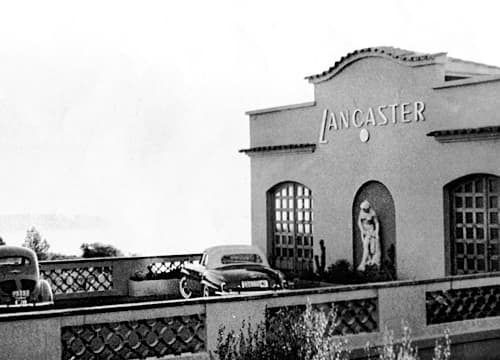
Above: Lancaster offices and factory in Monte-Carlo.
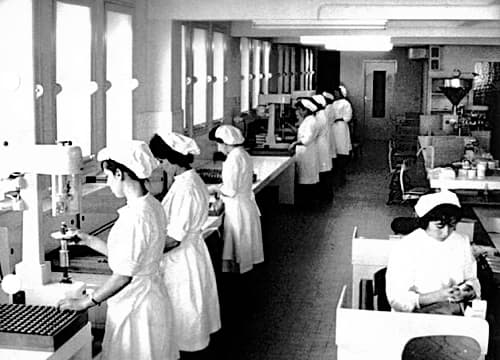
Above: Production line in the Lancaster factory in Monte-Carlo.
Lancaster’s initial markets were Monaco, France, and Algeria but these were extended to Switzerland, Italy, Spain, Venezuela, and Lebanon by 1956 with other European countries to follow. A British subsidiary, Lancaster de Paris Ltd., was not established until 1961 and Lancaster did not enter the American market until the 1970s.
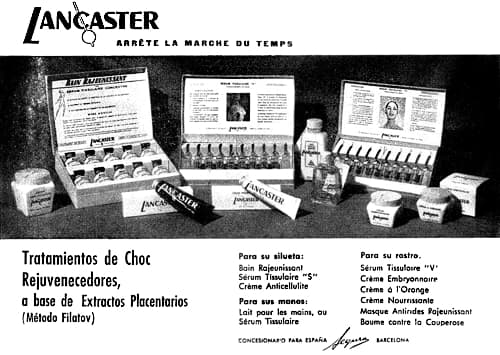
Above: 1960 Lancaster products available in Spain.
Würz and Frezzati founded two additional companies with connections to Lancaster. In 1955, Würz created Sud Publicité to handle promotions and advertising for Lancaster. Then, in 1959, Würz and Frezzati began the Société des Essences Aromatiques et Matières Premières to manage the fragrance side of the business. Lancaster had been selling fragrances since at least 1954, Mademoiselle de Paris Parfum and Midship Eau de Toilette, being early examples.
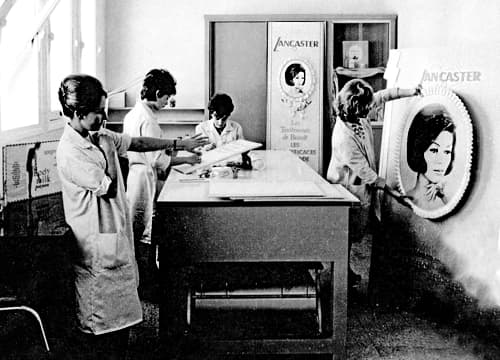
Above: Creating publicity materials for Lancaster.
Skin-care
Early skin-care cosmetics sold by Lancaster included: Lait de Démaquillage, Crème de Démaquillage, Crème Nourrissante, Crème Vivifiante, Crème Contre Les Pattes D’Oie, Lotion Astringent, Lotion Tonic, and Masque Anti-Rides, all conveniently named by function. The company also sold an Eyelash Cream (Crème Stimulante Pour Les Cils), a liquid lip rouge (Lipfilm), and a nail polish (Nailfilm) and remover.
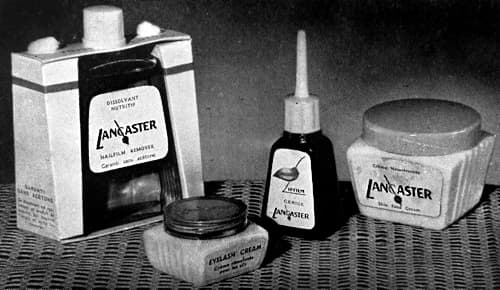
Above: 1950 Lancaster Nailfilm Remover, Eyelash Cream, Lipfilm, and Crème Nourrissante.
Treatment regime
The early Lancaster morning and evening treatment regimes emphasised the prevention and/or removal of wrinkles, the most common visual effect of ageing.
At night the skin was cleansed with Lait de Démaquillage or Crème de Démaquillage rubbed lightly over the skin with the fingers or a cotton pad moving in circles before it was removed with a towel. Then, Crème Nourrissante was massaged in with a light tapping action and left on to nourish the skin overnight. Mature women could use Crème Vivifiante and/or Crème Contre Les Pattes D’Oie instead.
Crème Nourrissante: A tonic cream that is applied in the evening after makeup removal. It is a preventive treatment that restores firmness to the tissues and prevents the formation of wrinkles.
Crème Vivifiante: A real beauty pomade; it cleanses the epidermis which, after a few applications, regains freshness and health. Its antiseptic and healing action quickly calms redness and pimple eruptions.
Crème Contre Les Pattes D’Oie: Specially formulated to prevent small wrinkles in the corners of the eyes that, if not taken care of, can become deep crow’s feet.
In the morning, Lotion Tonique was used to tighten the pores with Lotion Astringente being recommended for use twice a week. Women could then select a day cream according to their skin type – normal, oily, dry, or sensitive – Crème de Jour Peaux Normales et Grasses, Crème de Jour Peaux Sèches, or Crème de Jour Peaux Délicates.
Biologicals
In the 1950s, Lancaster added a range of skin-care cosmetics containing human placental extract produced according to the Méthode Filatov, a reference to the work done with tissue extracts by Vladimir Petrovich Filatov [1875-1956].
See also: Placental Creams and Serums
Early examples of Lancaster cosmetics containing placental extract were Sérum Tissulaire ‘V’ for the face (visage) and neck, Sérum Tissulaire ‘S’ for the breasts (seins).
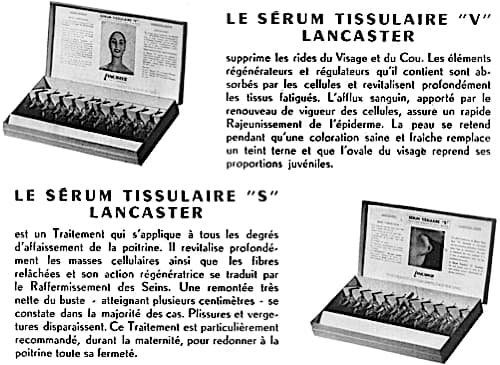
Above: 1958 Lancaster Sérum Tissulaire ‘V’ and ‘S’.
By 1954, other Lancaster cosmetics containing placental extract included: Crème Embryonnaire for wrinkles, jowls, and double chins; Bain Rajeunissant for cellulite; and Lait Pour Les Mains for brown spots, calluses and other problems associated with ageing hands. Results were not expected to be instantaneous with Lancaster suggesting that noticeable changes would only appear after 2 to 3 months of continuous use.

Above: 1954 Lancaster skin-care cosmetics with placental extracts.
Sérum Tissulaire ‘V’: Removes wrinkles from the face and neck. Skin tightens as a healthy, fresh colour replaces a dull complexion and the facial contours return to youthful proportions.
Sérum Tissulaire ‘S’: Deeply revitalises the cellular masses as well as the relaxed fibres and its regenerative action firms the breasts.
Crème Embryonnaire: The skin tightens and quickly regains its flexibility through deep tissue revitalisation. Recommended for all women over the age of 30.
Bain Rajeunissant: Tones the skin, mildly slimming too since it helps eliminate cellulite, the areas of puffiness which develop on thighs, hips, stomach and upper arms when rubbed vigorously on fat places.
Lait Pour Les Mains: An invigorating emulsion with a very high concentration of tissue extracts, restores and safeguards the beauty of the hands.
Later skin-care additions made with placental extracts included Sérum Tissulaire ‘D’ and Crème Vivante. Sérum Tissulaire ‘D’ was another bust treatment said to promote breast enlargement rather than the breast firming action of the earlier Sérum Tissulaire ‘S’. Crème Vivante, was promoted as a ‘physiological regenerator’ for the face. Composed of two parts, the smaller flask containing ‘stabilised living cells’ from a young animal was poured into a larger flask containing an emulsion made with placental extract. When shaken together these produced the Crème Vivante. Lancaster recommended taking the 30-day treatment 2-3 times a year.
Sérum Tissulaire ‘D’: Based on concentrated human placental extracts, for the under-developed bust. Safe, without any contraindications.
Crème Vivante: Based on stabilised living cells. Even after the first application you will see your face take on a new freshness and firmness of texture.
Treatment regime
As Lancaster expanded its skin-care range it also adjusted its daily treatment regime making greater allowances for different skin types.
As before, the evening regime began with a cleansing and purifying treatment. This involved removing make-up and cleansing the skin with Lait de Démaquillage (for normal or oily skin) or Crème de Démaquillage Fondante (for dry skins). Lancaster suggested that these preparations worked better than soap and water as the oils they contained would penetrate deeply into the pores to remove impurities while lubricating the skin and restoring its natural suppleness.
After cleansing, women could then select from a range of night creams to nourish and soften their skin. In addition to the earlier Crème Embryonnaire, Crème Nourrissante, Crème Vivifiante, and Crème Contre Les Pattes D’Oie, women could now elect to use Crème à L’Orange.

Above: 1958 Lancaster Crème Embryonnaire (Miracle Cream), Crème à L’Orange (Orange Cream), Crème Nourrissante (Skin Food Cream), and Crème Vivifiante (Reviving Cream).
Crème à L’Orange: Egg whites and nutrients from oranges help to keep the skin youthful and soft. A skin food for all skin types that need to be nourished to maintain or regain their suppleness. Should be used if Sérum Tissulaire ‘V’ is used.
The morning treatment involved cleansing and refreshing the skin with a tonic or astringent. There were now four of these to select from: a mild tonic for cleansing dry skin, a stronger tonic/astringent, a strong astringent for cleansing oily skin, and a camphor lotion used on oily skin that was prone to acne and blackheads.
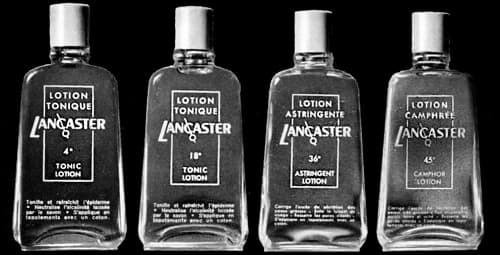
Above: 1958 Lancaster Lotion Tonique 4° (Tonic Lotion), Lotion Tonique 18° (Tonic Lotion), Lotion Astringent 36° (Astringent Lotion), and Lotion Camphrée 45° (Camphor Lotion).
Lotion Tonique 4°: For cleansing very dry and scaly skin.
Lotion Tonique 18°: Firms the muscles of the face and neck, refreshes the skin and neutralises the alkalinity left by soap.
Lotion Astringente 36°: Specially created for cleansing oily skin, correcting excess secretion and perspiration.
Lotion Camphrée 45°: Suitable for the treatment of oily skin prone to acne and blackheads. Tightens large pores.
By 1954, Lancaster was also selling a balm to treat and/or prevent couperose.
Baume Contre La Couperose: Applied as a lotion, this balm, which is a powerful vasoconstrictor, decongests the small red and unsightly veins, which prematurely age the prettiest faces.
After cleansing and toning, the skin was ready for a day cream. As before, women could choose from Crème de Jour Peaux Normales et Grasses, Crème de Jour Peaux Sèches, or Crème de Jour Peaux Délicates, according to their skin type, each available in pots or tubes. These creams were meant to be used under face powder and, by 1956, each came in six shades: Blanc, Naturel, Pêche, Ambre, Sahara, and Riviera.
Moisturiser
In 1957, the company replaced or renamed the earlier Crème de Jour Peaux Sèches with Crème Hydratante Peaux Sèches and added a lotion version as well – Lait Hydratant.
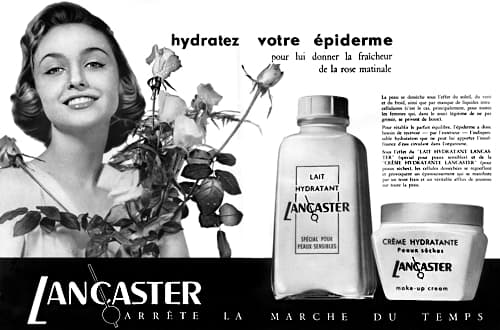
Above: 1957 Lancaster Lait Hydratant and Crème Hydratante.
This marks Lancaster’s entrance into hydrating/moisturising skin-care, a class of cosmetics that became increasingly important from now on.

Above: 1958 Lancaster Crème Hydratante Peaux Sèches (Make-up Cream), Crème de Jour Peaux Délicates (Sensitive Skin Cream), and Crème de Jour Peaux Normales et Grasses (Astringent Cream).
Sensitive skin
In 1959, Lancaster supplemented its Crème de Jour Peaux Délicates for sensitive skin with Juvenile Skin, a cream for delicate skin types prone to allergic reactions. Lancaster recommended that it be used with Lotion Tonique 4° in the morning, and Lait Hydratant at night.
Juvenile Skin: The truly sensational result of the fight against allergy, the cause of so much pain for hyper-sensitive skin. Enriched with precious substances, endowed with a completely exceptional penetrating power which facilitates the permanent renewal of epithelial cells. Your skin will quickly regain its suppleness, firmness and all the velvety freshness of a new youth.
By 1969, Lancaster had added a night cream version of Juvenile Skin so there were now two forms of this product – Juvenile Skin de Nuit and Juvenile Skin de Jour. Later still, Lancaster would add a lotion and a cleanser and group all four products into the Ligne Juvenile.
Other products
In addition to the previously mentioned Sérum Tissulaire ‘D’, other skin-care products introduced by Lancaster in the early 1960s included: Crème Tissulaire, a light, non-greasy, hydrating night cream; Crème Pour Le Cou, a neck firming cream made with tissue extracts; and Crème Anti-Cellulite, a massage cream to supplement Bain Rajeunissant.
Special mention should be made of Lancaster’s Emulsion Hydratante Solaire. Introduced by 1963, it was said to act as a moisturiser, sunscreen and tanning accelerator. It appears to have been the first sun-care product created by Lancaster.
Emulsion Hydratante Solaire: Moisturising: Protects from the drying action of the sun and the sea. Protective: Filters the short wavelength ultraviolet rays responsible for sunburn. Tanning: Accelerates skin pigmentation and allows for rapid coloration without damage or prolonged exposure to the sun.
Make-up
Lancaster only had a limited range of make-up by the end of the 1950s but it covered the basics. By 1958, as well as the older Lipfilm, the range now included Fond de Teint Souple (Foundation), Poudre Lancaster (Face Powder), Rouge Tissulaire Lancaster (Lipstick), Fard-Crème (Cream Rouge) and Brilliant Pour Paupières (Eye Shadow).
In the early 1960s Lancaster added a few products to its make-up range. Those that I know of are: Base Équilibriante, a hydrating, liquid powder base; Lancaster Mat, a fluid make-up with good covering power sold in tubes in six shades; and Skincolor, another fluid make-up in seven shades.
Later developments
Lancaster had included English names on the labels of most of its cosmetics possibly to make it easier to sell its cosmetics to wealthy English speakers holidaying in Monaco or the French Riviera. However, as previously mentioned, Lancaster did not set up outlets in Britain until the 1960s with the establishment of Lancaster de Paris Ltd. in Britain in 1961, or the United States until 1970.
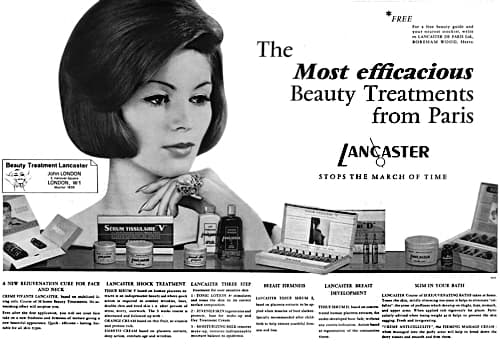
Above: 1965 Lancaster (Britain).
The company did not open a salon in London but Lancaster salon treatments were available through John London, 3 Hanover Square, Mayfair. A similar arrangement had been established in Paris with Jacy de Paris which became the main Paris outlet for Lancaster through to 1965.
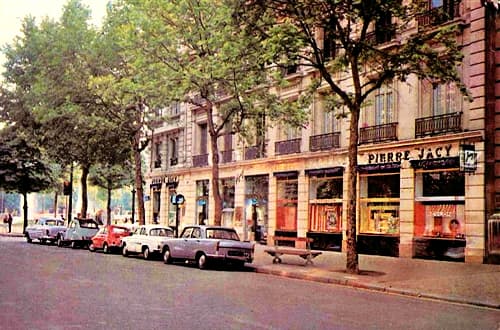
Above: 1965 Jacy de Paris at Rond-Point des Champs-Élysées.
In 1965, the company opened the Lancaster Boutique at 65 Rue du Faubourg Saint-Honoré, Paris. Theis new facility included a beauty school used to train students in Lancaster beauty-care cosmetics and methods.
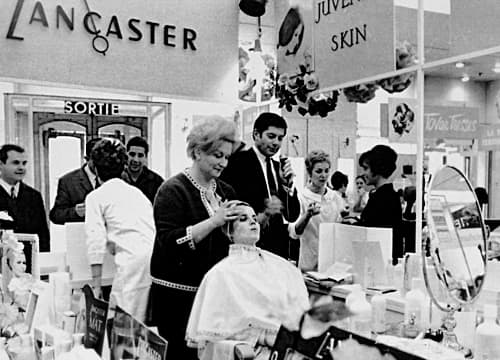
Above: c.1959 Lancaster Boutique, Paris. It was moved to 9 Place de la Madeleine by 1970 before being closed a few years later.
In 1965, Lancaster was also appointed as a Fournisseur Breveté de S.A.S. La Princesse Grace de Monaco (Patent Supplier of H.S.H. Princess Grace of Monaco) which allowed the company to display her coat of arms in their advertising.
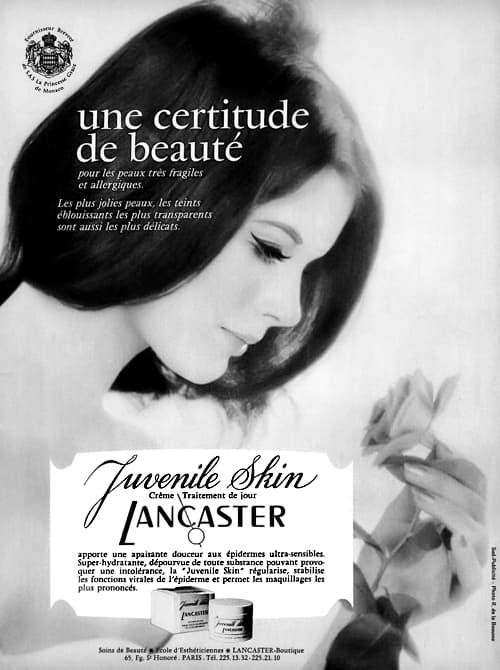
Above: c.1968 Lancaster Juvenile Skin with the Princess Grace of Monaco crest in the top left hand corner.
Sale
In 1967, the Beecham Group acquired a majority holding in Lancaster for US$8 million. By this time, Lancaster had begun advertising its Ligne Princière, presumably to capitalise on its relationship with Princess Grace. This was largely a rebranding exercise with much of the range made up of preexisting products. The company discontinued the line after Grace Kelly died tragically in a car crash in 1982.
After Beecham purchased the company it introduced Lancaster into the United States, strengthened Lancaster’s make-up range and added new sun-care products creating the foundations of the Ligne Solaire for which Lancaster is best known today.
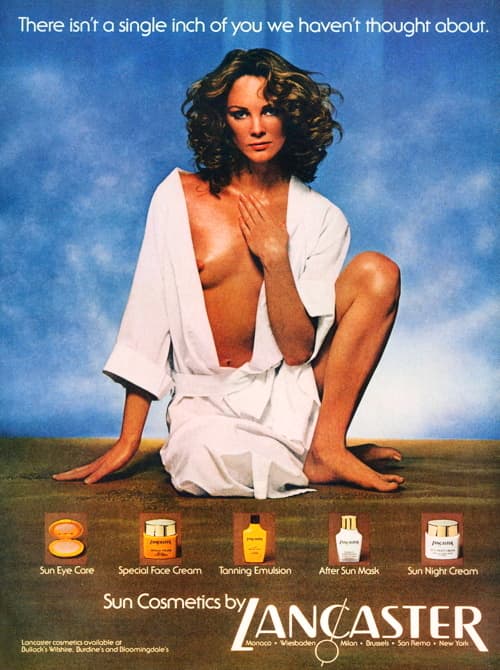
Above: 1978 Lancaster Sun Care System.
Beecham merged with SmithKline Beckman in 1989, and, in 1990, the new company, SmithKline Beecham, sold Lancaster along with Margaret Astor to Joh. A. Benckiser G.m.b.H. of West Germany for US$358 million in a deal that included manufacturing facilities in West Germany, Monaco, Chartres and Barcelona. The American arm of Benckiser bought Coty in 1992 and, in 1996, Lancaster was combined with a number of other luxury brands to become the Lancaster Division within the Coty Group, a position it still holds today.
Timeline
| 1947 | Lancaster S.A.M. founded in Monaco. |
| 1948 | Factory opened in Monte-Carlo. |
| 1951 | New Products: Sèrum Tissulaire “V” and “S”. |
| 1954 | New Products: Bain Rajeunissant, and Baume Contre la Couperose. |
| 1955 | Sud Publicité founded in Monaco. New Products: Crème à L’Orange. |
| 1957 | New Products: Lait Hydratant. |
| 1959 | Société des Essences Aromatiques et Matières Premières established in Monaco. New Products: Juvenile Skin. |
| 1961 | Lancaster de Paris Ltd. established in Britain. |
| 1965 | Lancaster Boutique opened in Paris. Royal appointment to Princess Grace. |
| 1967 | Beecham acquires a majority holding in Lancaster. |
| 1970 | Lancaster marketed in the United States. |
| 1990 | Beecham sells Lancaster to Benckiser. |
First Posted: 5th December 2020
Last Update: 25th January 2023
Sources
Journal de Monaco. Monaco: Imprimerie Nationale de Monaco.
Lancaster. (c.1950). Le traitement de beauté [Booklet]. Monaco: Author.
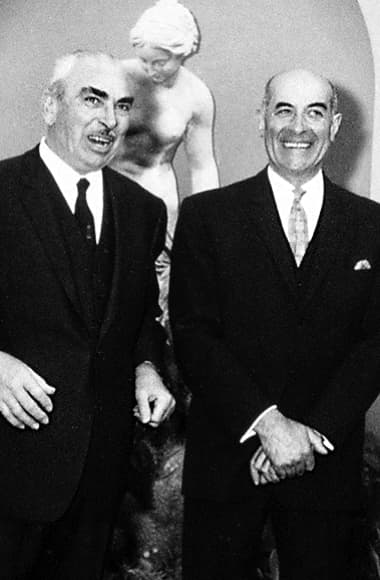
Dr. Eugène Frezzati [1907-1970] (left) and Georges Louis Bernard Würz [1911-2002] (right).
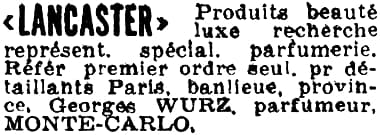
1945 Lancaster produits beauté luxe.
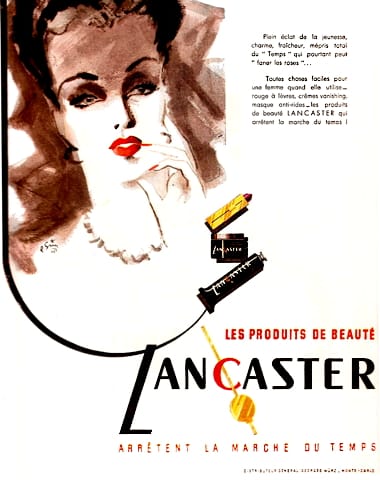
1946 Lancaster Rouge à Lèvres (automatic lipstick), Crème Vanishing (jar), and Masque Anti-rides (tube).
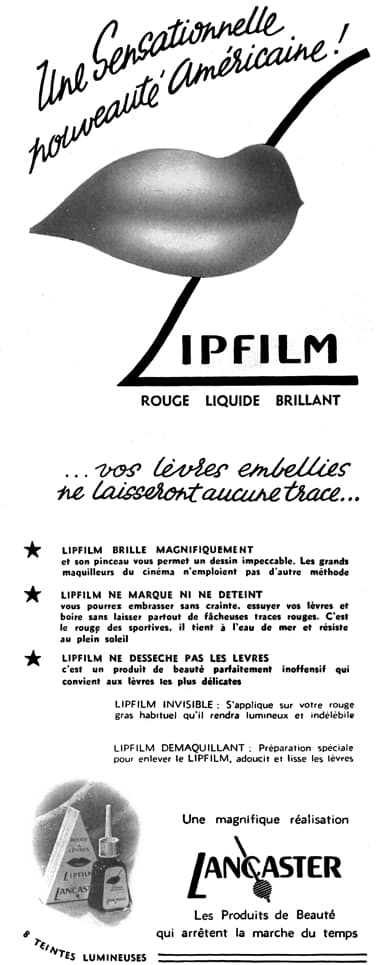
1948 Lancaster Lipfilm.
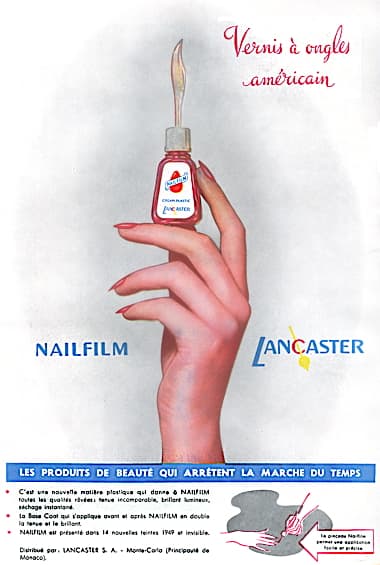
1948 Lancaster Nailfilm.
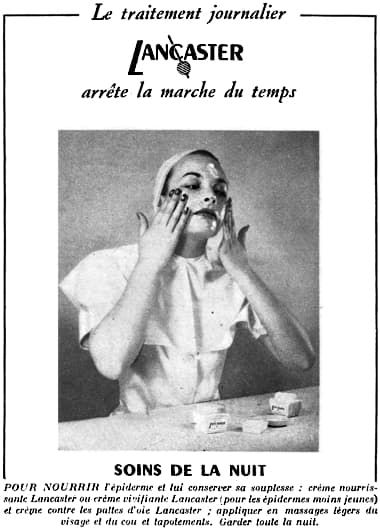
1949 Lancaster night care – Crème Nourrissante, Crème Vivifiante, and Crème Contre Les Pattes D’Oie.

1949 Lancaster Masque Antirides.

1953 Lancaster Le Traitement de Beauté.
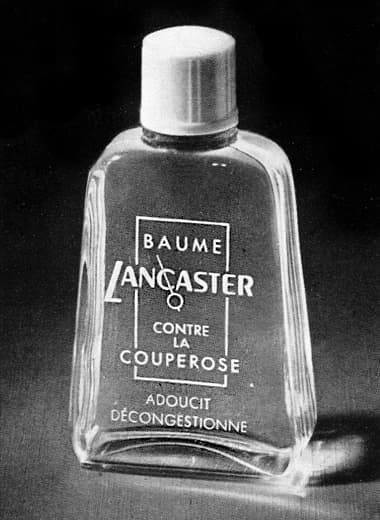
1954 Baume Lancaster Contre La Couperose.
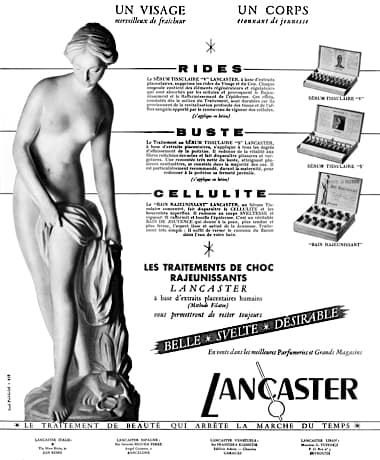
1956 Lancaster Sérum Tissulaire “V” for wrinkles, Sérum Tissulaire “S” for the bust, and Bain Rajeunissant for cellulite.
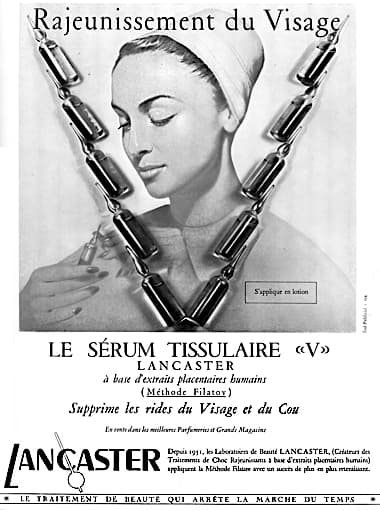
1956 Lancaster Sérum Tissulaire “V”.
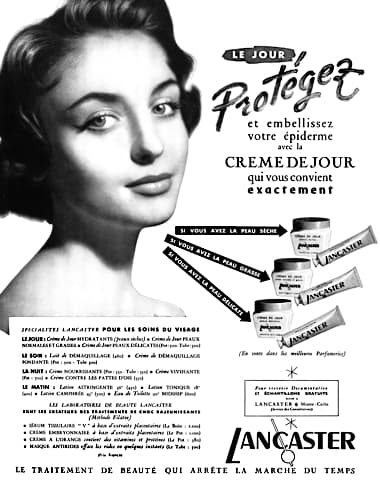
Above: 1956 Lancaster Crème de Jour Peaux Normales et Grasses, Crème de Jour Peaux Sèches, and Crème de Jour Peaux Délicates.
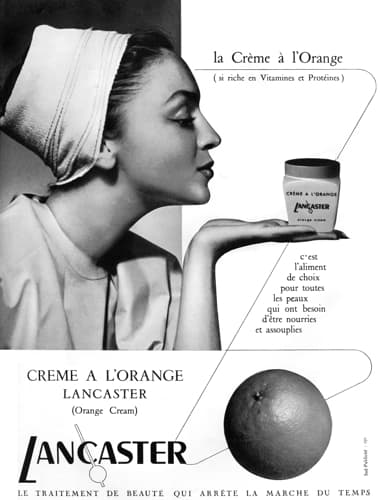
1956 Lancaster Crème à L’Orange.

1957 Lancaster Crème Embryonnaire.

1958 Lancaster Lait de Démaquillage (Liquid Cleansing Cream) and Crème de Démaquillage (Liquefying Cream).
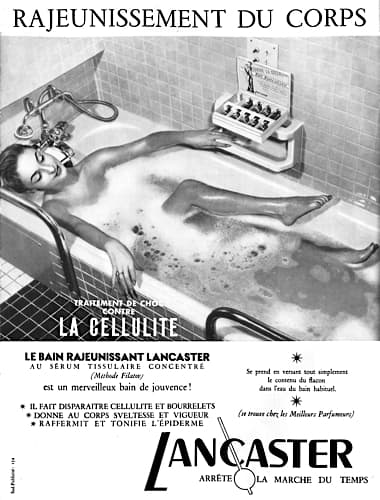
1958 Lancaster Bain Rajeunissant.

1959 Lancaster Juvenile Skin.
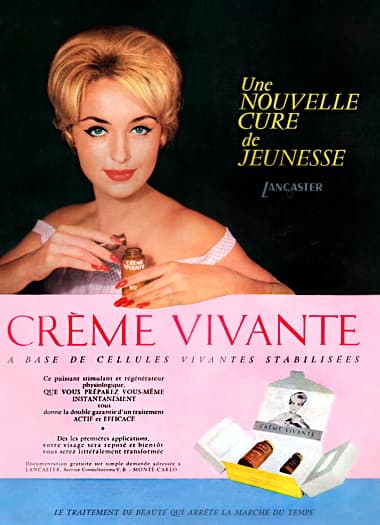
1960 Lancaster Crème Vivante composed of two parts. The smaller flask containing ‘stabilised living cells’ from a young animal was poured into a larger flask containing a placentary emulsion and the mixture was then shaken.
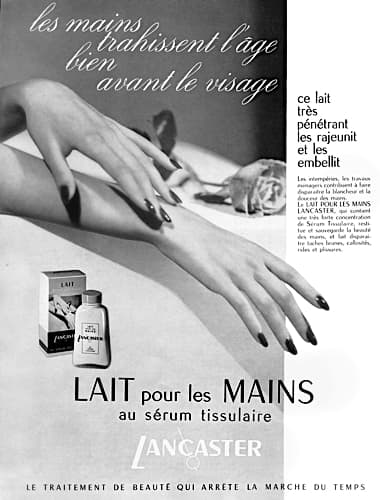
1963 Lancaster Lait Pour Les Mains.
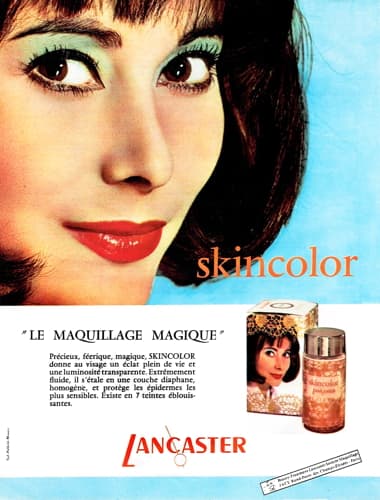
1963 Lancaster Skincolor.
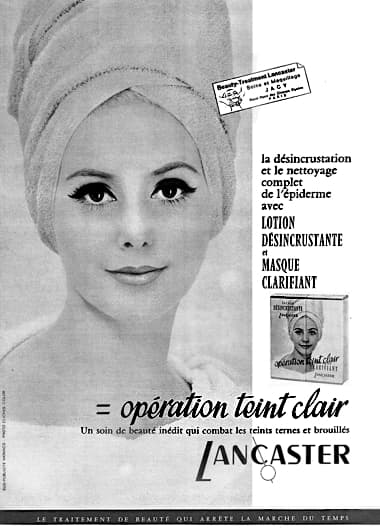
1964 Lancaster Lotion Désincrustante and Masque Clarifiant.
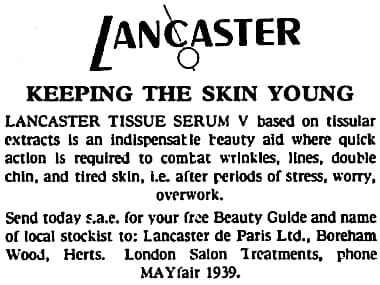
1965 Lancaster de Paris Tissue Serum V (Britain).
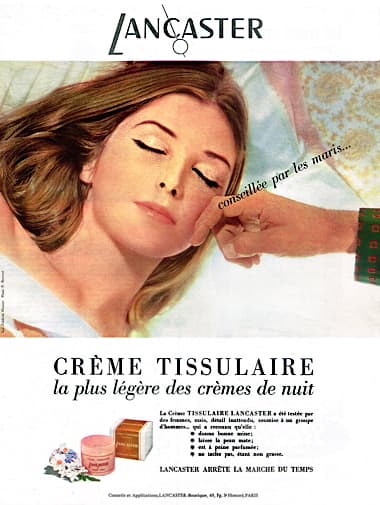
1965 Lancaster Crème Tissulaire.

1965 Lancaster Base Équilbrante.
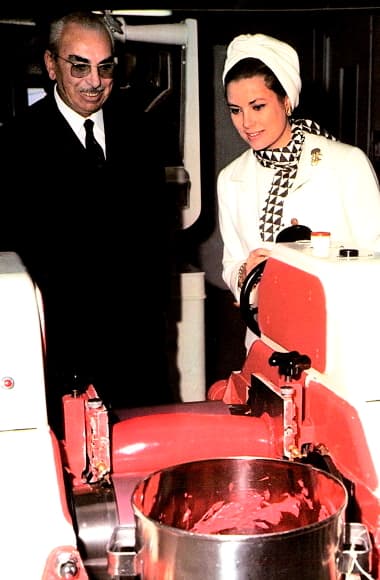
1967 Princess Grace [1929-1982] getting a guided tour of the Lancaster factory by Dr. Eugène Frezzati.
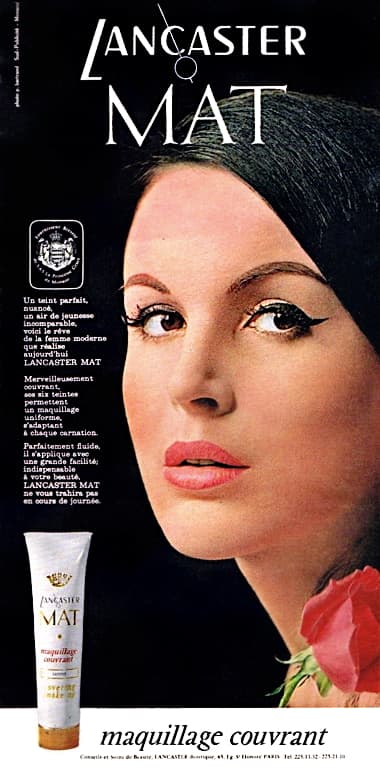
1967 Lancaster Mat.
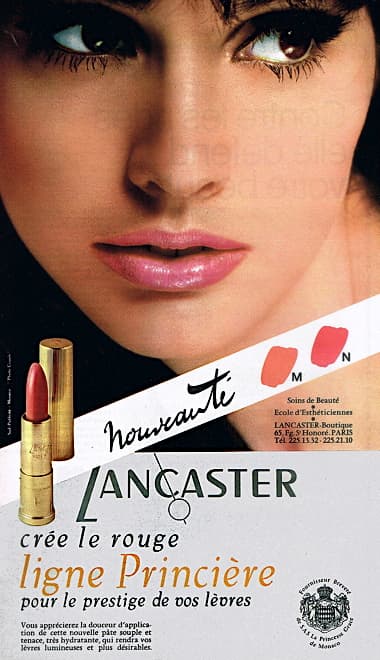
1968 Lancaster Ligne Princière.
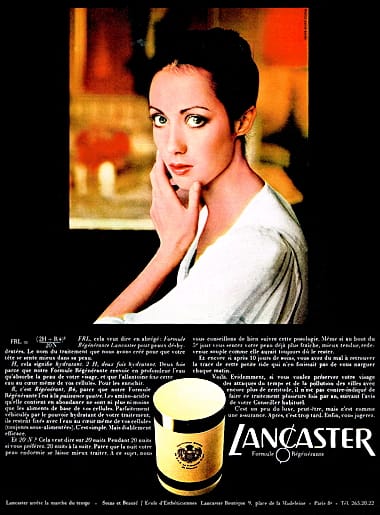
1971 Lancaster Formule Régenérante. The clock pendulum has been moved in the Lancaster title.
